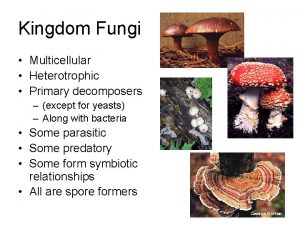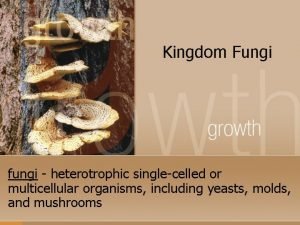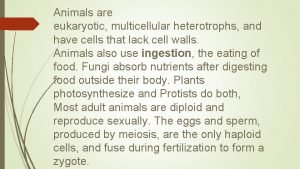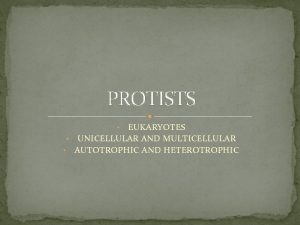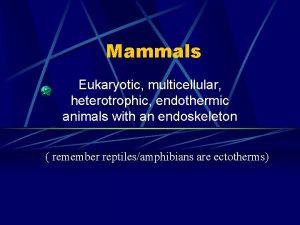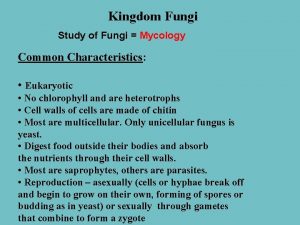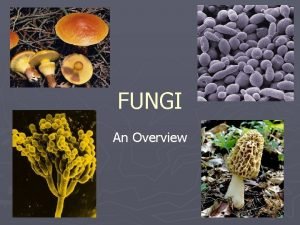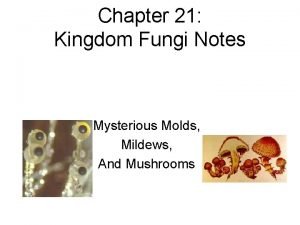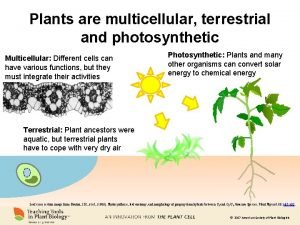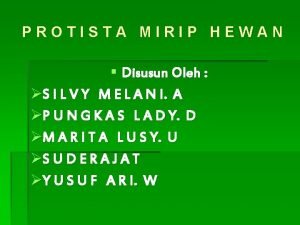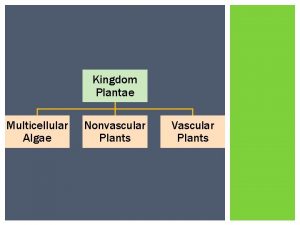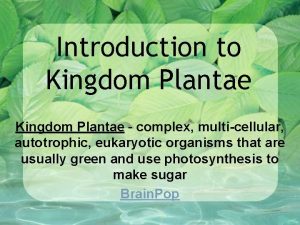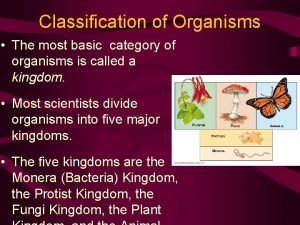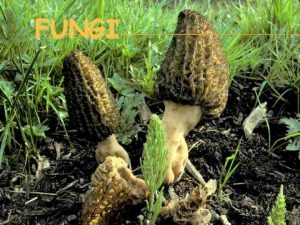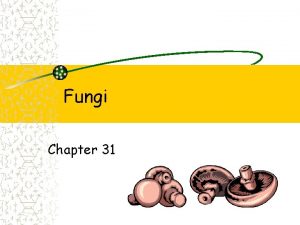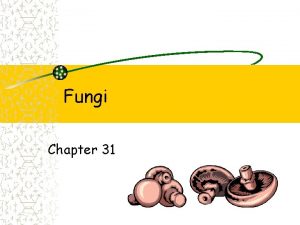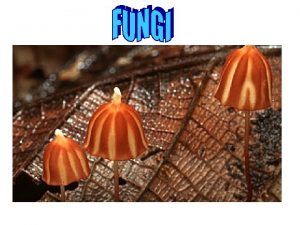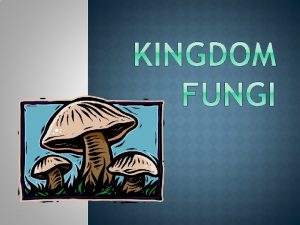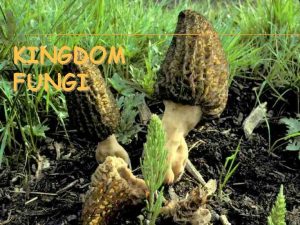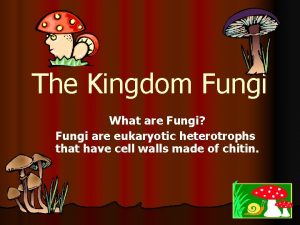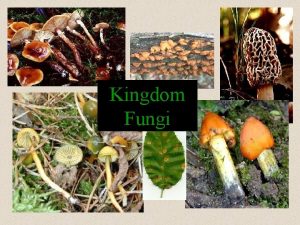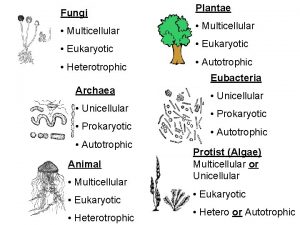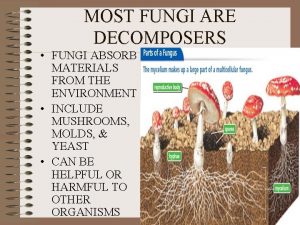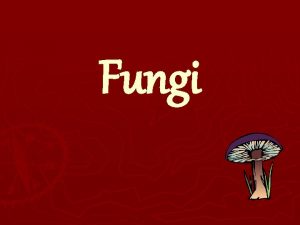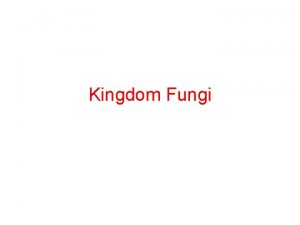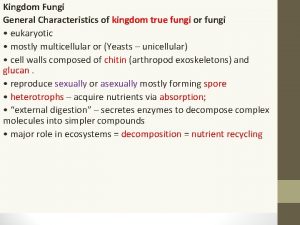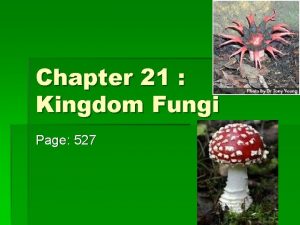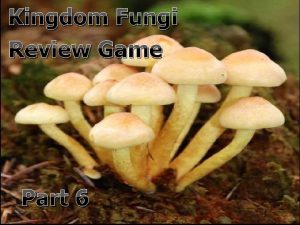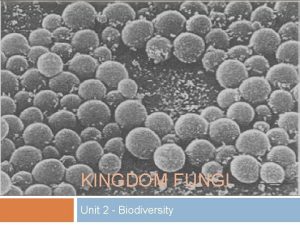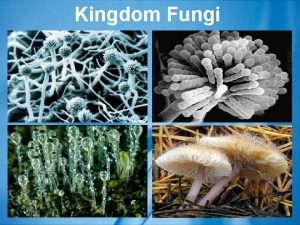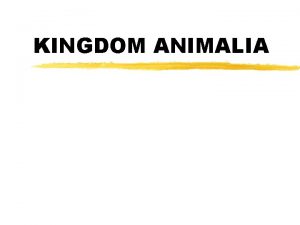Kingdom Fungi Multicellular Heterotrophic Primary decomposers except for

























- Slides: 25

Kingdom Fungi • Multicellular • Heterotrophic • Primary decomposers – (except for yeasts) – Along with bacteria • Some parasitic • Some predatory • Some form symbiotic relationships • All are spore formers



Fungal Parasites • Parasitic to plants – Hyphae absorb photosynthetic products • Parasitic to animals – Hyphae capture and feed on nematodes and protists

• Symbiotic with algae or bacteria – Fungi get food from photosynthesizing algae – Algae get protection from drying out

Kingdom Plantae • Food production and O 2 • Bryophytes – mosses – Transition from water to land – Lack vascular system • Ferns – Seedless vascular plants; but still need water to fertilize • Gymnosperms – conifers (e. g. , pines, spruce) – Seeds not encased in fruit – fertilize by wind-blown pollen • Angiosperms – flowering plants – Seeds encased in fruit (promote seed dispersal) – e. g. , flowers, grains, oaks, cactus…

Kingdom Animalia • • Multicellular Heterotrophs Lack cell walls Embryology – Blastula stage

Phylum Porifera • Sponges • Habitat – Mostly marine, few freshwater • Body plan = asymmetry • Filter feeder • Cellular level (lacks true tissues and organs) • Reproduction – Sexual and Asexual

Phylum Cnidaria (nigh-dare-ia) • Jellyfish, sea anemones, coral • Nearly all marine • Radial symmetry • Two forms: medusa (swimming) and polyp • Tissue level • Reproduction – Sexual and budding • Stinging cells – cnidocytes

Phylum Platyhelminthes • Flatworms • Marine, freshwater, or moist land • Bilateral symmetry • Organ level • Reproduction: hermaphrodites – Asexual and Sexual • Many parasitic

Phylum Nematoda • Roundworms • All environments • Complete gut – Have mouth and anus • Reproduction – Always sexual • Many parasitic

Phylum Mollusca • Gastropods (Snails, slugs) • Bivalves (oysters, clams, mussels) • Cephalopods (squid, cuttlefish, octopus) • Marine, freshwater, moist land • Secretes shell • Locomotive foot

Phylum Annelida • Segmented worms – Repetitive body parts – Hydrostatic skeleton • Flexibility and strength – Earthworms – Leeches • Marine, moist land, and some freshwater • Bilateral symmetry • Some parasitic

Phylum Arthropoda • Insects, spiders, crabs, shrimp, centipedes • Aquatic and land • External skeleton • Jointed bilateral appendages • Segmented body • Open circulatory system

Phylum Echinodermata • Spiny skin • Sea stars, sea urchins, sea cucumbers • All marine; mostly benthic (sea floor) • Radial symmetry • Some regenerate asexually

Phylum chordata • Vertebrates, lancelets, sea squirts • All environments • Notochord – Flexible rod-like structure • Dorsal nerve cord – Tube for nerves • Pharyngeal gill slits – Respiration and feeding • Post-anal tail – Reabsorbed in some species

Sea squirts • Primitive chordate – All chordate characters as free-swimming larva – Loses post-anal tail • Sessile adults • Filter feeder • Compound, colonial, or solitary

Fish • Class Chondricthyes – Cartilagenous fishes • Sharks, rays, and skates • Class Osteichthyes – Bony fish • Gives rise to tetrapods – Four-limbed vertebrates • Two chamber heart

Class Amphibia • First terrestrial vertebrates • Frogs, salamanders, newts • Requires moist environments at least • Most lose post anal tail & gill slits • External fertilization • Three chamber heart

Class Reptilia • Dinosaurs, turtles, lizards, snakes, crocodiles, alligators • Evolved from amphibians • First sign of amniotic egg – Key to transition to land – Keeps embryo moist • Internal fertilization • Tough, scaly skin – Prevents desiccation

Class Aves (Birds) • Descendants of reptiles • Adapted for flight – – Feathers Wings Light bones Flight muscles/breastbone • Four-chamber heart • Extensive respiratory system

Class Mammalia • Brain sizes are larger pound of body weight than most other animals'. • Mammals have more efficient control over their body temperatures than do birds. • Hair provides insulation. • Mammary glands provide milk to nourish the young. • Teeth are specialized for cutting, shearing or grinding; thick enamel helps prevent teeth from wearing out.

Order Monotremata • Egg laying mammals – Australia & New Zealand – Only 2 Families living • Platypus • Echidna

Order Marsupialia • Pouched mammals – Born in the embryonic stage; finish outside the mothers body (pouch) – Largely Australian • Koala, Kangaroo, Tasmanian Devil – Few North American • opossum

Placental Mammals • Embryos nourished by placenta for extended gestation periods – 9 mos. = human – 2 yrs. = elephant • 12 Orders that include: – Bats, horses, whales, rodents, cats, dogs, and primates (monkeys, apes, & humans)
 Fungi are also called multicellular decomposers
Fungi are also called multicellular decomposers Threadlike fungi examples
Threadlike fungi examples Is kingdom fungi unicellular or multicellular
Is kingdom fungi unicellular or multicellular All animals are multicellular heterotrophs
All animals are multicellular heterotrophs Heterotrophic eukaryotes
Heterotrophic eukaryotes Eutherian mammals
Eutherian mammals Are protists eukaryotic
Are protists eukaryotic Share
Share Protista
Protista Old kingdom middle kingdom new kingdom
Old kingdom middle kingdom new kingdom Old kingdom middle kingdom new kingdom
Old kingdom middle kingdom new kingdom Old kingdom middle kingdom new kingdom
Old kingdom middle kingdom new kingdom Mentohotep
Mentohotep Are fungi heterotrophs
Are fungi heterotrophs Kingdom fungi uniseluler atau multiseluler
Kingdom fungi uniseluler atau multiseluler Yeast kingdom
Yeast kingdom Are fungi multicellular
Are fungi multicellular Fungi
Fungi All members of kingdom fungi are _____________________.
All members of kingdom fungi are _____________________. Photosynthetic multicellular and terrestrial
Photosynthetic multicellular and terrestrial Is protista unicellular or multicellular
Is protista unicellular or multicellular Phyrophyta
Phyrophyta Is seaweed vascular or nonvascular
Is seaweed vascular or nonvascular Multicellular eukaryotic autotrophic organisms
Multicellular eukaryotic autotrophic organisms Kingdoms that contain consumers
Kingdoms that contain consumers Haustorium in fungi
Haustorium in fungi
